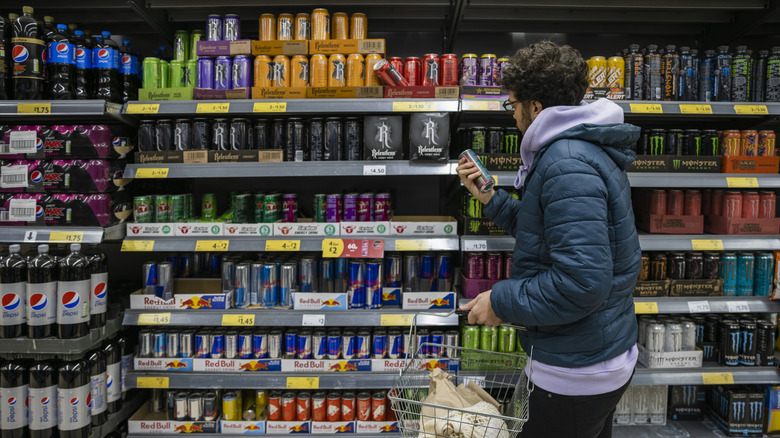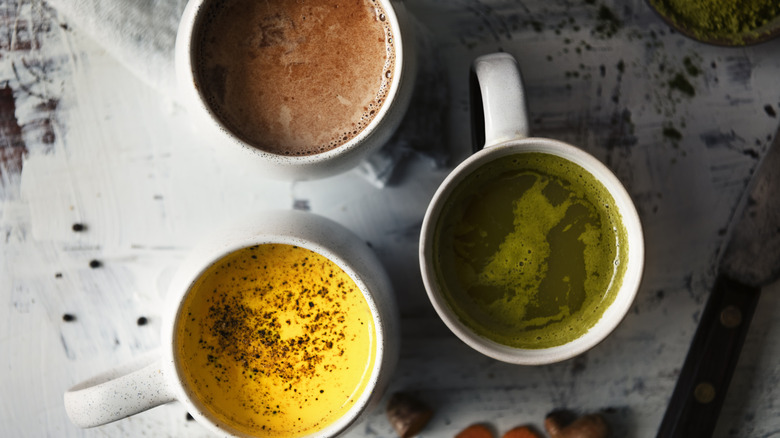What's The Difference Between Natural And Synthetic Caffeine?
Whether it's part of your busy morning run or delicious homemade drink, caffeine has become one of the most normalized ways to navigate the rhythms of modern living. A pick-me-up from your morning cup of tea, a midday boost via energy drinks, a long-standing coffee habit — there are so many sources of caffeine. And with the rise of synthetic forms of the chemical, many question how much they truly know about the world of caffeinated beverages.
Maybe you want to get your hands on some caffeine to stimulate your central nervous system, or maybe you just want a nice coffee ice cream. Regardless, it's best to get an understanding of where you'll typically find each version of caffeine and why. Whether it is coming from superfood Amazonian berries or from chemically cultivated sources, the differences between synthetic and natural caffeine are subtle but significant.
What to know about synthetic caffeine
Synthetic or alternative caffeine is known as caffeine anhydrous, which just means dehydrated caffeine. While natural caffeine is produced from resources derived from the earth, its synthetic form is a man-made creation that dates back to the 1940s. Research suggests that there is no chemical difference between natural and synthetic caffeine.
The synthetic form of caffeine has a pretty lengthy chemical origin story. In a nutshell, it starts off as ammonia, which is then converted into urea. The next step is to combine it with chloroacetic acid, which produces uracil. Uracil is then processed and converted to another chemical — theophylline. Finally, a dash of methyl chloride is added to officially create what you know as synthetic caffeine, scientifically named methylated theophylline. You are most likely to find it in soda and energy drinks since it is cheaper to mass-produce in mass, and the ingredients list will likely simply list "caffeine." There are currently no specific regulations for sodas and energy drinks from the U.S. Food and Drug Administration (FDA), i.e. whether the caffeine used is synthetic or natural.
With the rise in demand for energy boosting beverages across the world, synthetic caffeine is being used more and more frequently than ever before . For instance, in its humble genesis in St. Louis, Missouri, Coca-Cola's main source of caffeine used to be tea leaves. Nowadays, factory-created synthetic caffeine is used as an additive thanks to the demands of the modern lifestyle. Japan is the only country in the world that requires natural sources of caffeine from tea leaves or coffee beans in all food and drink rather than synthetically produced versions.
What to know about natural caffeine
In its natural form, caffeine is derived from several sources, some of the most common being the fruit, leaves, and beans of coffee, cacao, and green tea. Other key sources include the kola nut found in West African rainforests, oolong tea traditionally found in China, maca from the Andes region, guarana and guayusa from the Amazon, as well as cacao nibs, matcha, and black tea. The list goes on, too — there are over 60 species of plants known to contain natural caffeine, and the multitude of options come with their different strengths and impacts on the body. For instance, there's a world of difference between the caffeine in a cup of coffee and yerba mate, a traditional South American beverage.
Unlike synthetic versions of caffeine, its natural form is accompanied by compounds that bring added benefits when absorbed. In coffee, it adds antioxidants, manganese, magnesium, potassium, phosphorus, and an array of B vitamins. So your trusty morning cup gives you a little bit more than a wake-up call and is doing some extra work behind the scenes that synthetic caffeine can't.
Natural caffeine is also usually labelled as the ingredient itself rather than "caffeine." For example, if you purchase a chocolate cake, the ingredient on the packaging will read "chocolate," in line with the FDA requirements. The plant-derived caffeine sources are also extracted using either simple and traditional methods such as soaking green tea leaves or through retention during the decaffeinated process. These methods help preserve the rich flavor profiles and potential nutritional values that find their way into each much-needed sip.


